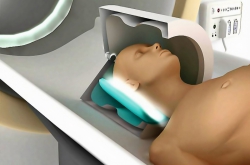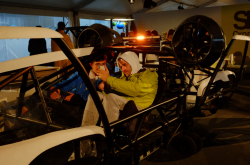The competition was held among scientific teams developing innovative projects at enterprises and universities of St. Petersburg. Winners were determined in three categories: “Best scientific innovation”, “Best innovative business solution” and “Best innovative product”. In each category, projects from six areas were included: nanosystems; information and telecommunication systems; life sciences; sustainable use of natural resources; transport and aerospace systems; energy efficiency, supply and nuclear energy. Researchers from the Department of Nanophotonics and Nanomaterials, Alexey Slobozhanyuk and Alena Schelokova participated in the first category in the area of life sciences with their project “Use of wireless RF coils for improvement of MR imaging”.
“We try to take part in all the competitions that are relevant to our project’s scientific field. Unfortunately, there are few of those, but still, some exist. We believe that taking part in such initiatives has a positive effect on our project’s development, motivates us and serves as a good source of publicity. Since the awards ceremony was held at the St. Petersburg International Innovation Forum, we had the opportunity to find new acquaintances, get in touch with colleagues we’re already familiar with and find out useful things at the event’s workshops and roundtables,” – comments Polina Petrova, the project’s manager from the Department’s Innovations Commercialization Office.

The project aims to develop and initiate the production of innovative radiofrequency coils that improve the functions of magnetic resonance imaging (MRI) units. Nowadays, MRI diagnostics are used all over the world not just for medical purposes, but also for various scientific research related to biology or human anatomy. The imaging process, however, is quite time-consuming, much longer than a CT or an ultrasound scan. Patients must spend 25 to 50 minutes motionless inside the unit, which is uncomfortable for patients and means that patients have to be put on waiting lists. This is caused by the fact that magnetic resonance has a low signal-to-noise ratio and, in order to increase it, the signal needs to be accumulated. The ratio in question has a great effect on the quality and resolution of the final image.
The signal-to-noise ratio is affected by the strength of a tomograph’s constant magnetic field, measured in teslas. Today, hospitals in Russia tend to use middle-field MRI units with a strength of 1.5 tesla, which are already being phased out by three-tesla units, which produce sharper images. However, fields of that strength can have harmful effects on human health, including overheating of organic tissue. Seven-tesla tomographs also exist and are used for scientific research; they have their own drawbacks, too, as expensive and massive equipment is needed to provide cooling to such machines. All this means that it is futile to attempt to increase the effectiveness of medical MRI machines just by strengthening their magnetic fields; other solutions have to be found.
This is exactly what ITMO University’s scientific team is trying to do. As part of the project, wireless radio-frequency “MetaCoils” were designed in order to improve the MRI resolution using metamaterials. The coils emit a powerful ultra-short wave signal that, upon contact with organic tissue, becomes a valid signal and provides imaging of the organs being scanned. The signal can be locally reinforced using a metasurface – a periodic structure of conducting copper strips. Scientists have attached these elements to a thin flexible substrate and integrated them into the close-fitting receiving coil arrays inside the MRI scanner. Placed between the patient and the receiver coils, the metasurface increases the signal-to-noise ratio in the region of interest. This way, scientists can redistribute electromagnetic waves inside the tomograph in a more optimal way, amplifying them in sections where it is needed.

Comparison of MRI scans made with and without the metasurface
Experimental testing of this invention was conducted at Leiden University’s Medical Center (the Netherlands). For the test, a patient’s knee was placed directly on the metasurface-enhanced wireless coil. As a result, images taken using both low- and middle-field tomographs showed an increase in quality. It is expected that the metasurface substrates can shorten the scan time by 1.7 times while increasing the quality of images twofold. Moreover, these coils are useful in that they do not need to be connected to the machine – being wireless, they are simply placed under the area being scanned. This means that hospitals and medical centers will not need to buy expensive new scanners.
The project team intends to develop radio-frequency coils of varied geometry for scanning the various parts of the body: head, spine and limbs. The devices will also be placed in a special hypo-allergic plastic casing to create a more diverse and appealing product line. Retail sales of the coils are expected to begin in 2018-2019. According to estimates, for the project to recoup its costs, the company would need to sell three of the cheapest coils each month. The researchers have determined that there are approximately three thousand MRI units being used in Russia, but they are also looking at the markets in Japan, China, USA, Europe and CIS countries. P&S Market Research estimated that in 2015 the MRI market was valued at $5.4 billion. In the period from 2016 to 2022, the market will grow by 5% yearly.





